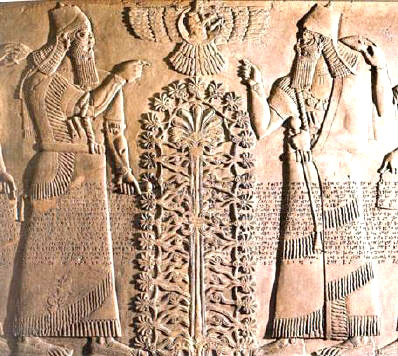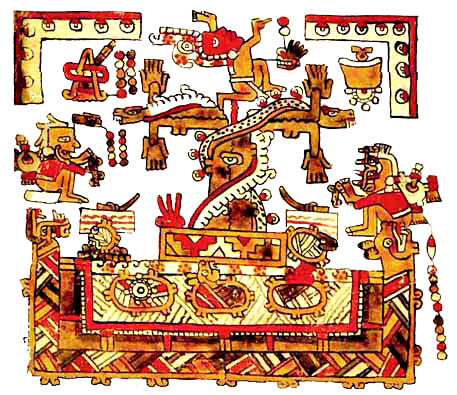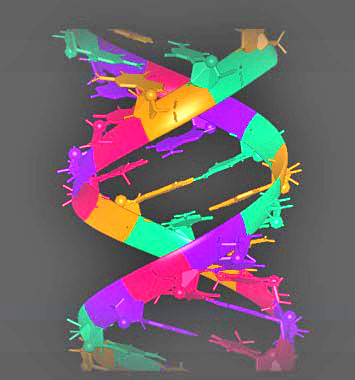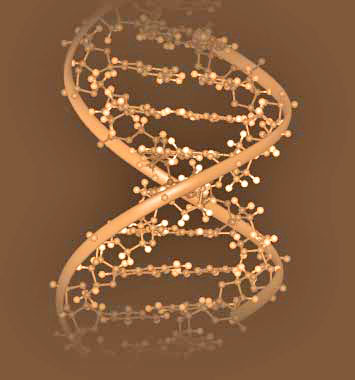|

from
WorldMysteries Website
|
To suppose that earth is the only populated world in infinite space is as
absurd as to believe that in an entire field sown with millet, only one
grain will grow.
.
Metrodorus of Chios
4th century B.C. |
A DNA molecule consists of a ladder, formed of sugars and phosphates, and
four nucleotide bases:
-
adenine (A)
-
thymine (T)
-
cytosine (C)
-
guanine (G)
The genetic code is specified by the order of the nucleotide bases, and
each gene possesses a unique sequence of base pairs. Scientists use these
base sequences to locate the position of genes on chromosomes and to
construct a map of the entire human genome.
The Human Genome Project (HGP) is an international research program designed
to construct detailed genetic and physical maps of the human genome, to
determine the complete nucleotide sequence of human DNA, to localize the
estimated 50,000-100,000 genes within the human genome, and to perform
similar analyses on the genomes of several other organisms used extensively
in research laboratories as model systems.
The scientific products of the
HGP will comprise a resource of detailed information about the structure,
organization and function of human DNA, information that constitutes the
basic set of inherited "instructions" for the development and functioning of
a human being. Successfully accomplishing these ambitious goals will demand
the development of a variety of new technologies.
It will also necessitate
advanced means of making the information widely available to scientists,
physicians, and others in order that the results may be rapidly used for the
public good. Improved technology for biomedical research will thus be
another important product of the HGP. From the inception of the
HGP, it was
clearly recognized that acquisition and use of such genetic knowledge would
have momentous implications for both individuals and society and would pose
a number of policy choices for public and professional deliberation.
Analysis of the ethical, legal, and social implications of genetic knowledge,
and the development of policy options for public consideration are therefore
yet another major component of the human genome research effort.
The Human Genome project revealed that human beings have 30,000-40,000
genes. That number is much lower than expected.
For example, fruit fly has 13,300 genes, roundworm - 18,300 genes, mustard
weed - 25,700 genes.
According to genetic analysis, though, more than 98% of human DNA is
identical to chimpanzee DNA. In fact, chimpanzees are more closely related
to humans than orangutans and gorillas. "Humans are simply odd looking apes,"
psychologist Roger Fouts of Central Washington University in Ellensburg,
Washington, writes in his 1997 book, Next of Kin: My Conversations With
Chimpanzees.
"A traveler from an antique land... lives within us all," claims
Sykes, a
professor of genetics at Oxford. This unique traveler is mitochondrial DNA,
and, as this provocative account illustrates, it can help scientists and
archeologists piece together the history of the human race. Find out more by
reading this book: The Seven Daughters of Eve: The Science That Reveals Our Genetic Ancestry by
Bryan Sykes.
Controversial Discoveries
|
A 3.5-million-year-old fossil, flat-faced human from Kenya -
Kenyanthropus
platy-ops, suggests the human family tree is a lot more complicated than we
knew.
Implication is clear: More than one species of pre-human was wandering
around Africa a few million years ago, and it's anyone's guess which of them
evolved into human race.
Fred Spoor
University College, London |
Several years ago, spearpoints and other tools of modern man were found
under a layer of volcanic ash. When Dr. McIntyre, a member of the U.S.
Geological Survey, was invited to date the overlying ash, the archaeologists
thought it could be as old as 20,000 years old, pushing the arrival of man
in the New World back around 5,000 years.
No one was prepared when uranium
series dating and fission tracking methods provided the astounding age of
250,000 years. Dr. McIntyre shares what happened next:
"I thought, okay, we
got something big here but I'm going to stick with the dates. I didn't
realize it was going to ruin my whole career."
Tree of Life

Mesopotamian "Tree of Life"

The Olmec "Tree of Life" (Mesoamerican Cosmology).
The lineage founder, 2 Grass, is being born from a twisting World
Tree.
Detail from Selden Codex page 2. Source: FAMSI
DNA - our modern "Tree of Life"

|




